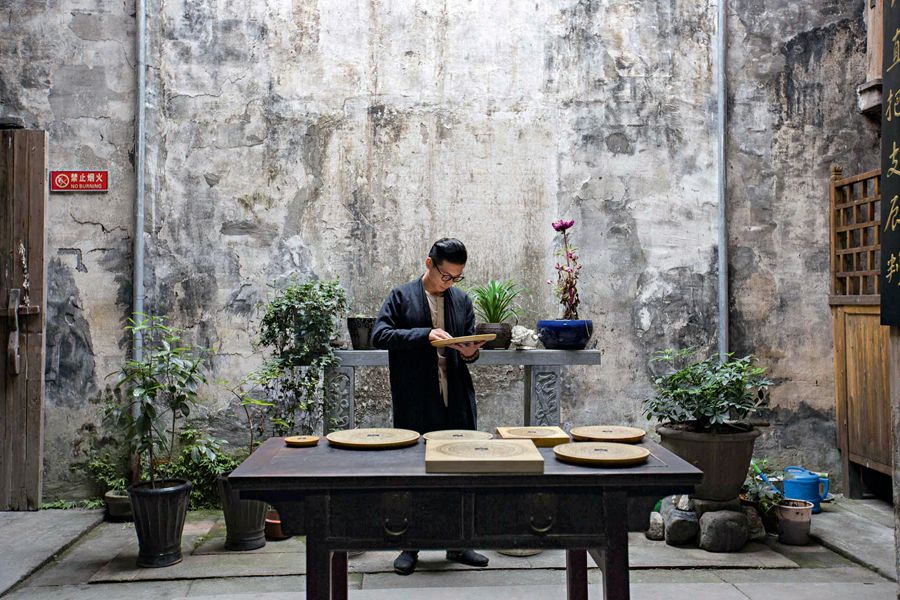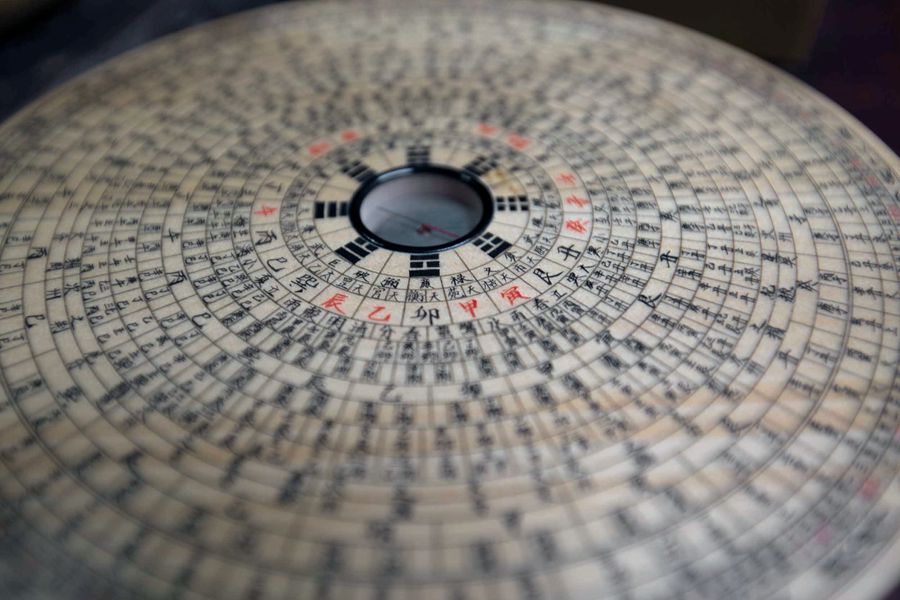THE traditional Chinese compass is a geomagnetic instrument invented in ancient China. It is widely used in astronomy, geography, military, and navigation, and in selecting the sites of residences and tombs. It is one of the four great inventions of ancient China, but is rarely used as a navigation tool in modern times.
As a handicraft and specialized fengshui instrument, Wan’an compass carries cultural information on ancient Chinese astronomy, geography, environment, philosophy, studies of the Book of Changes, and architecture. This kind of compass provides valuable information for studying the history of ancient Chinese science and technology, society, human settlements, and the regional culture of ancient Huizhou.
Unity Between Man and Nature
China has always been an agricultural country. The history of agriculture dates back thousands of years, during which Chinese farmers would track the change in climate and arrange their farming work according to the law of the heaven and the earth. In an era of underdeveloped technology, as a traditional Chinese saying goes, “Farmers live at the mercy of the elements.” In good weather, there would be a bountiful harvest; yet natural disasters would reduce the crop yield.
The dependence on nature led ancient Chinese to think that humans are an integral part of nature. In the face of nature, human beings seem small and powerless. Man is inseparable from nature. Only when humans conform to nature, can they gain vitality. Therefore, the laws of nature should be followed to achieve harmony between man and nature. This is the philosophical thought of “unity between man and nature” – the dominating belief of traditional Chinese culture.
The concept of “unity between man and nature” is not only the core of Chinese philosophical thinking, but also embodied in social life, running through food, clothing, housing, and transportation – basic necessities of life. In different fields, people seek the best form of unity between nature and man in different ways.

In ancient times, compasses were widely used by China’s Huizhou merchants to calculate the fengshui of their future residences in order to select auspicious locations.
Ancient Chinese respected and observed nature, and, on this basis, summed up a set of methods to understand and adapt to nature. For example, people chose the best date for doing things by resorting to divination. This came from people’s exploration of the laws of the universe. Such pursuit of harmony between man and nature was embodied in all aspects of people’s lives: from state affairs such as sacrifices, deployment of troops, ground breaking of projects to major events like marriage and trivial matters like traveling, eating and dressing, all of which had to be carried out at a specific time so that everything could go smoothly.
In addition, people would always choose the best orientation. Houses, usually the most valuable property of ordinary people, were made from wood in ancient times and were susceptible to various accidents, such as fires and collapses. The repair and construction of houses became a major event in people’s life, as it was a matter of life and death.
People had been pursuing good luck in building or repairing houses since ancient times. They chose the auspicious day for ground breaking and the right location to build the house on. They also made the house face towards an auspicious direction in order to receive the divine protection of deities and protect occupants from all kinds of disasters. In this way, people would live a long and healthy life. This method of choosing the right place eventually developed into one category of metaphysics – the theory of geomantic omen, or fengshui.
Fengshui and the Chinese Compass
The theory of fengshui or geomantic omen, is about the studies on people’s living environment and the choice of geographical locations. It pursue harmony between nature, buildings, and human beings. The theory involves a wide range of disciplines and natural sciences like geography, geology, astrology, meteorology, architecture, landscape science, ecology, psychology and information science on human life.
The theory originates from the Book of Changes, the oldest of the Chinese classics. With a history of 5,000 years of application, it has become the basic philosophy of the Chinese nation to understand the world, and the theoretical roots of natural philosophy and humanistic practice in traditional Chinese culture. The book has been continuously supplemented and perfected by various generations of sages. Fengshui had profound impacts on China’s politics, economy, and culture for thousands of years.

The surface of the compass is covered with many concentric circles, geographical locations, solar terms, and astronomical calendars inscribed in a certain order from center to rim.
Fengshui is an all-encompassing concept. In essence, it is the selection of a natural environment that is friendly to human beings. For example, the ancients paid great attention to the influence of the sun on human beings, and preferred to houses facing to the south. This is because China is in the Northern Hemisphere. For most of the time, the sun stays in the southern direction. With windows and doors facing south, the room will receive more sunshine. An example is found in the courtyards in the north of China. With rooms of four sides enclosing the central yard, the layout ensures the privacy of the residence, and facilitates fresh air to get into the rooms.
Before the invention of the Chinese compass, people could not accurately distinguish azimuth, an angular measurement in a spherical coordinate system. Only the eight directions of east, west, south, north, southeast, northeast, southwest, and northwest could be used to describe the direction and orientation. The emergence and development of the compass made the measurement of direction more precise. Based on the compass positioning, the fengshui master imprints the jargons such as the Eight Diagrams, Heavenly Stems, the Twelve Earthly Branches and solar terms on a circular disk, with the compass in the center. The horizontal plane is measured with the disk. Different schools of fengshui have different jargon printed on the compass. Therefore, the Chinese compass can be dubbed an encyclopedia of Chinese numerology.
The compass is an indispensable positioning tool for the fengshui master. In ancient China, the fengshui master was in great demand, with a compass reading called for positioning either the overall planning of a city or interior decoration.
For example, in Beijing, the capital city for Yuan, Ming, and Qing dynasties from the 13th to the early 20th century, the main palaces are located on its central axis running from north to south. This type of architectural layout and orientation reflects the traditional Chinese Confucian culture. It is also suitable for the natural environment which means buildings require sufficient sunshine in the cold winter in the north.
The central axis, measuring 7.86 km in length, connects Beijing’s outer city, inner city, and the Forbidden City. Extending this central axis 270 km northward reaches Shangdu, the founding capital of the Yuan Dynasty. Just one year after its founding, the Yuan emperor moved the capital to Beijing. At that time, there was no global positioning system, but the ancient people managed to contain the linear error of such a long distance to 0.2 degrees through the sole use of the compass. It shows the preciseness of fengshui and the accuracy of positioning at that time.
Wan’an Compass
The Wan’an compass was named after its birthplace of Wan’an Town, Xiuning County, Anhui Province.
About 1,000 years ago, there was a man named He Pu. He was a fengshui consultant to the royal family of the Southern Tang, one of the 10 kingdoms in south China created following the Tang Dynasty. He was demoted to Xiuning as chief of the county, which was suffering frequently from heavy floods. By using his own theory of fengshui, he relocated the county to a higher place and saved it from floods after that.
He Pu also practiced fengshui for the ordinary people. Gradually, the compass he often used spread to Wan’an, a place rich in Chinese bishop wood. The wood is the ideal for making compasses. Compass making thus became an important industry in this ancient town. During the Ming and Qing dynasties, entrepreneurial Huizhou merchants, a group of people who valued fengshui, brought the Wan’an compass to places across the country as they traveled for business.
The Wan’an compass has strict requirements on raw materials and processing. Generally made of Chinese bishop wood or ginkgo wood, it is produced through a series of steps, including forging, lathing, and burnishing. Large ones have a diameter about 30 cm, and the small ones are about the size of the palm of a hand.
Production of the compass takes about three to five months, and goes through seven processes. First of all, the Chinese bishop wood or ginkgo wood should be air-dried for more than three years to remove moisture. In this way, the compass will never warp. The air-dried wood is turned into a disc using a lathe according to different diameters and thicknesses, with the magnetic needle placed in the center.
Based on fengshui schools, 12 bisectors with a central angle of 30 degrees are depicted on the compass, and these bisectors are taken into different gradations by different radii. The small grids should be written with a brush, which requires care and patience. After writing begins a unique traditional process to smelt the oil. The compass needs to be oiled many times. This process determines the brightness of the compass, ensuring that the compass is still clean and clear after 100 years.
The last core technique is to install a compass. Due to the instrument’s role of positioning, the accuracy of the pointer directly affects the fengshui master’s judgment. It is the core element of the compass. This skill is often reserved as a family heritage, and is generally not passed on to people outside the family.
Because of the carefully selected materials and intricate craftsmanship, the Wan’an compass is unique. Zheng He (1371-1433), a renowned Chinese mariner and explorer in the Ming Dynasty, installed the Wan’an compass on his ship as a navigation device, while commanding expeditionary voyages to the West. At the Panama-Pacific International Exposition held in San Francisco, the United States, in 1915, the Wan’an compass, along with the sundial, won gold medals.
In 2006, the craftsmanship of making the Wan’an compass was included in the first batch of national intangible cultural heritages of China.
(Compiled by China Today)

